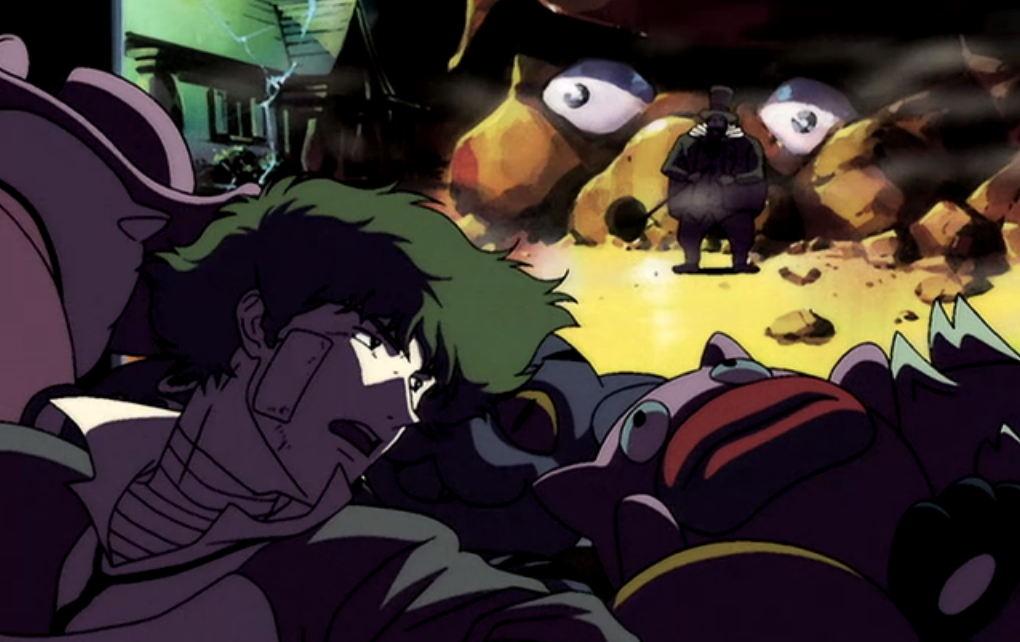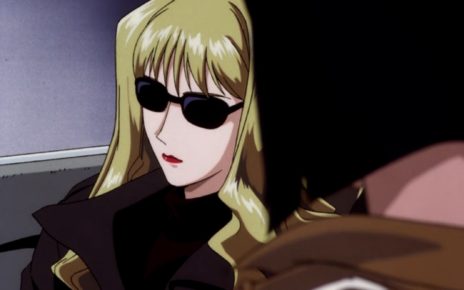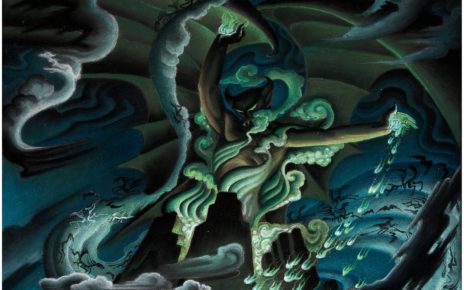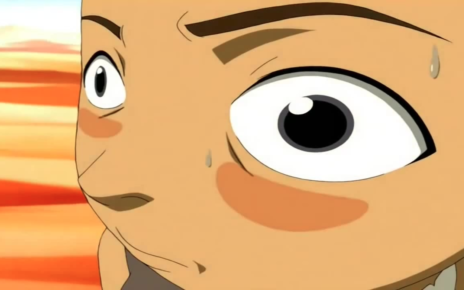Session 20: Pierrot le Fou

For one month, The Dot and Line is publishing essays, interviews, and discussions about each episode of Cowboy Bebop, which turns 20 this April.
It begins and ends in silence. A city cast in shadow, the slightest tint of nostalgia, as if one might have accidentally fired up an episode of Batman: The Animated Series. A misunderstanding waits around the corner.
Watching the episode “Pierrot le Fou” is in many ways a jarring experience, one that borders on absolute horror—a psychological nightmare parsed from the id. There’s something so ominous, every frame painted over in clashing colors, light and dark, determination and doubt. When compared to the rest of the series, it stands out, almost as if its mere existence were accidental, a nightmare we were never supposed to see.
It’s one of the few episodes in which money isn’t involved. Spike and the crew don’t take on a bounty or follow the usual routine of search, capture, and survive. Nothing really happens in the grand sense of a prevailing narrative arc. Spike’s out and about, and one might assume this is what he does when he’s looking to be alone — hit up a bar or two, drink some bourbon, hustle a few rounds of pool. Smoke way too many cigarettes and maybe grab a quick bite to eat from a food cart before making his way back to the Bebop. Sometimes you need a little time to yourself. Yet like most things that appear simple at first, something sinister lingers just beneath the surface.
It just so happens that the night Spike walks the city, there’s a psychopath out for the kill, and his name is Mad Pierrot. On the surface, he fits the name — looking as much like a crossbreed of different nightmarish Bat-verse villains like the Joker and the Penguin as much as he exemplifies the archetypal jester, or clown — a trickster, complete with a sinister smile and chuckle. Spike isn’t just targeted by the villain, either. He’s almost destroyed in an unbelievable sequence culminating with enough sequential backflips to keep him airborne, seeing that the normally superb hand-to-hand fighter is completely pulverized five times before hitting the ground. We haven’t seen Spike in such a weak light before. From the city where it all starts, much like the theme park where the episode concludes, the hunt is an anomalous mirror—a nameless vision of our darkest, most vulnerable caverns of the mind.
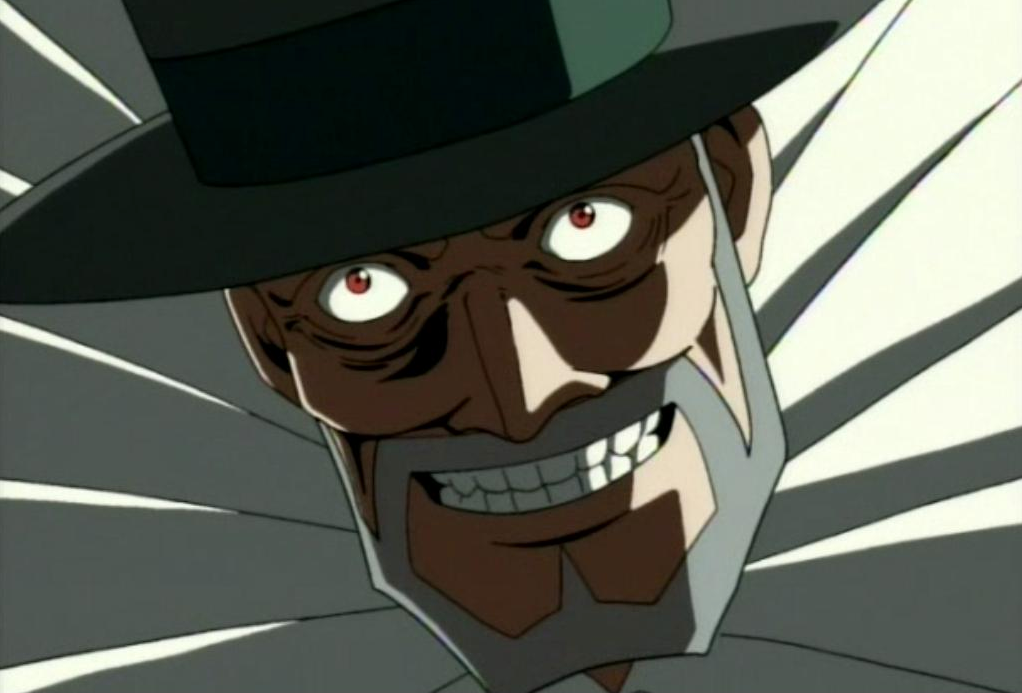
After escaping the city, broken and recovering, Spike hesitates in seeking revenge as he learns about Mad Pierrot from Jet’s received intel. Real name: Tongpu. Occupation: genetic test subject. Motive: none. The constant experiments have rendered his body replete with incredible abilities, including superhuman strength, speed, and a kinetic shield that makes him nearly immortal, yet his mind has regressed to that of a child. He is a killing machine running on the exuberance of a young child curious about each and every attack. He mistakes laughter for sadness, grief for gratitude.
Pierrot obsesses over Spike — the laughter echoing throughout the episode becomes a reflection of this obsession. He can’t get Spike out of his mind. Dig a little deeper and you’ll see that the tricks, and obsession, aren’t strictly for the kill, but are truly his only means of relating to others. What begins with cruelty should culminate in the splendor of an understanding—to grow, we must be willing to learn lessons from our pasts. But not Pierrot. Not even close. Oh, kids can be so cruel.
As for Spike, there’s no running from this problem. Likewise, we know of what quietly haunts our protagonist, and one can’t help but see through each animated frame to those near-vulnerable moments, those flickers where Spike breaks his trademark calm exterior, unable to keep up his usual apathetic demeanor. As we reach the final set-piece of the episode—an amusement park, almost as if we were watching a different show—which might be harmless if it weren’t pulled up from the deepest recesses of our antagonist’s mind, we return to silence. The lone sounds in the distance are Spike’s footsteps coming closer, as if they were echoes of reminiscences of his own past, just withheld.
Mad Pierrot is always one step ahead of Spike, except in this—he, too, is unable to move on, frozen in time. The fear of each unseen gunshot pushes Spike to the brink as Pierrot snickers, evident that for him, it’s always been a game. Understanding right from wrong involves learning. Until then, we are reacting only with the very thing that can break us: emotion.
A child operates on the prompts and peculiarities of emotion, unfiltered and pure. Happiness is sadness is confusion is nightmare; Pierrot’s aim to kill is his aim to relate, or at least engage, with Spike. Torture and kill a spider because it’s gross and captivating, or let it free? The child knows no difference. The legs of a spider are removed and inspected, much like Mad Pierrot lures Spike deeper into the theme park. To Pierrot, this is what it means to get along.
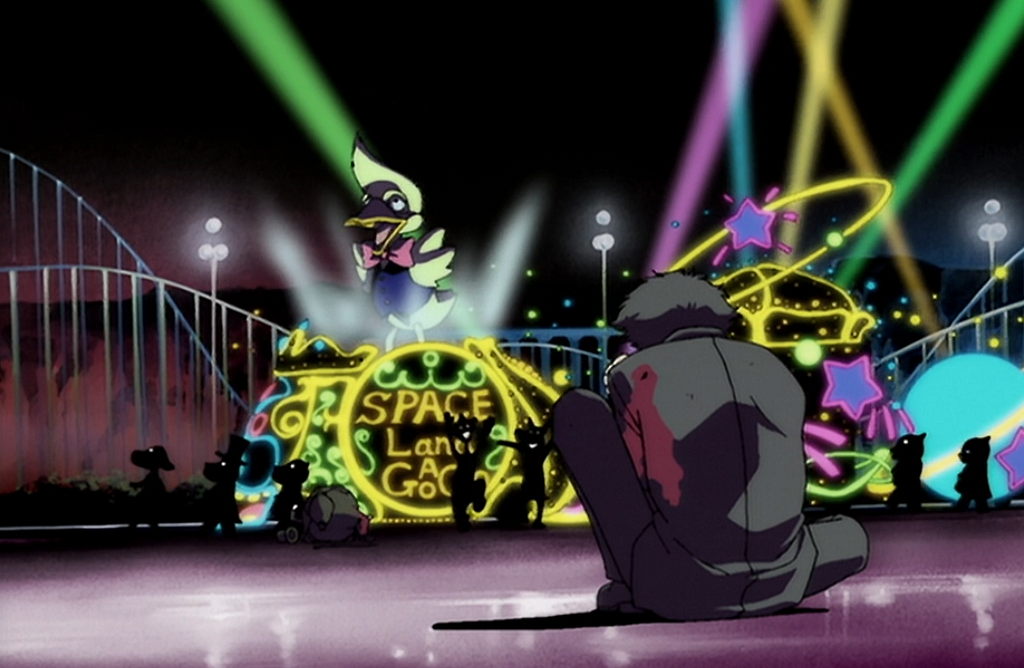
Laughter, always laughter — we are bombarded with horror imagery, roller-coaster racket, eerie music and gunfire. How do you kill what cannot be killed? How do you teach a rebellious child? They trade spots by the end, with Mad Pierrot, triggered by a memory, slipping enough to get the lesson he deserves. His laughter fades, replaced with a full-on tantrum, tears and all, as the very thing he hoped would destroy Spike ends up destroying him. He calls out, louder and more affecting with each shout: Mommy! Mommy!
With every cry we see it more clearly, staring right back at us: a madman as child who buckles in the face of the traumas that made him what he was; a contract killer that hides from his past so effectively it can never find him; an ill-fitting episode in a well-beloved animated series about people so good at running from their pasts that they deny themselves a future.
“Pierrot le Fou” is a rare glimpse of Spike being chased into a corner to the point of a near-reveal—almost as if it’s a hint at the particulars of his childhood, which we’ll never know and, as such, never understand. What was he running from? What’s he running toward? But like he tells Jet, after Pierrot has been flattened by one of his own inventions, “I don’t need the info anymore.”
We are denied Tongpu’s actual past. We know of the tests, we know of the aftermath, we know of the madness, the loose screw gone awry, but we don’t know what came before, who he was before that horror. And in spite of all the screen time we have with Spike, we only know who he became from the moment he joined a crime syndicate. He set his sights on a life in the temporary, complete with never having to put down roots. As such, he can’t see to the end of the proverbial tunnel, and neither can we.
Earlier in the series, Spike says he hates kids, animals, and “women with attitudes.” It’s a reminder of aspects of living that allow a view of a bigger picture of humanity—aspects the enigmatic crew of the Bebop adamantly rejects: putting down roots, allowing a moment of vulnerability, letting go.
A pause, the episode regressing to silence before fading to black. So what have we learned? “I hate theme parks,” Spike says. We will never know why, and perhaps there’s nothing more frightening than that.

Thanks for reading The Dot and Line, where we talk about animation of all kinds. Don’t forget to for this article and follow us on Twitter and Facebook.


